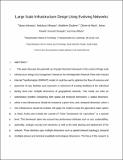Large Scale Infrastructure Design Using Evolving Networks
Author(s)
Ishimatsu, Takuto; Alhassan, Abdulaziz; Doufene, Abdelkrim; de Weck, Olivier; Alsaati, Adnan; Strzepek, Kenneth; Alfaris, Anas; ... Show more Show less
DownloadLarge Scale Infrastructure Design Using Evolving Networks.pdf (1.196Mb)
Terms of use
Metadata
Show full item recordAbstract
This paper discusses the potential use of graph-theoretic framework in the context of large scale infrastructure design and management. Named as the Interdependent Network Flow with Induced Internal Transformation (INFINIT) model, it could be used to optimize the flow of resources and placement of new facilities (and expansion or retirement of existing facilities) at the individual facility level over multiple dimensions of geographical networks. This model can solve an optimization problem considering both spatial and temporal dimensions: a spatial dimension, where a new infrastructure should be invested at a given time; and a temporal dimension, when a new infrastructure should be invested. We apply the model to study the agriculture water system in Saudi Arabia and evaluate the concept of “Solar Desalination for Agriculture” at a national level. This framework takes into account key performance attributes such as cost, sustainability, optimality, strategic security and robustness as well as the ideal phasing and deployment of the network. These attributes span multiple dimensions such as spatial (network topology), temporal (multiple phases) and technical (available technologies) dimensions. The focus of this research is to demonstrate the applicability of the INFINIT for modeling and assessment of agricultural water system in Saudi Arabia.
Date issued
2020-06-13Keywords
graph-theoretic framework, large scale infrastructure design and management, national water systems, agriculture
Collections
The following license files are associated with this item: